View in other NatureServe Network Field Guides
NatureServe
Montana
Utah
Wyoming
Idaho
Wisconsin
British Columbia
South Carolina
Yukon
California
New York
White Heelsplitter - Lasmigona complanata
General Description
The White Heelsplitter is a relatively common mussel in North America, and has been recently introduced into MT. It can
be found as far south as the Tennessee River, throughout the Midwest and Plains States (native in SD, ND) and into southern Canada. The White Heelsplitter prefers pools or sluggish streams with a mud, sand, or fine gravel bottom. Known host fish species include the Common Carp, Green Sunfish, Largemouth Bass, White Crappie, Orangespotted Sunfish and Banded Killfish, all these are introduced or exotic species in Montana.
Diagnostic Characteristics
"Shell elliptical, compressed, mahogany brown; disk roughened only by growth lines; two poorly defined ridges extend from the beaks to the posterior edge and on the posterior slope near the beaks are three or four low folds; beaks not very high, sculptured by 2 or 3 small ridges that are more or less W-shaped; interior pearly white, with two slanting pseudocardinals in one valve and one in the other; lateral teeth broad, low, and not very long; beak cavities shallow; anterior muscle scars broad, deep; posterior scars scarcely showing against the pearly nacre; L. 130, H. 100, D. 32 mm." (La Rocque 1967:191).
Species Range
Montana Range
Range Descriptions
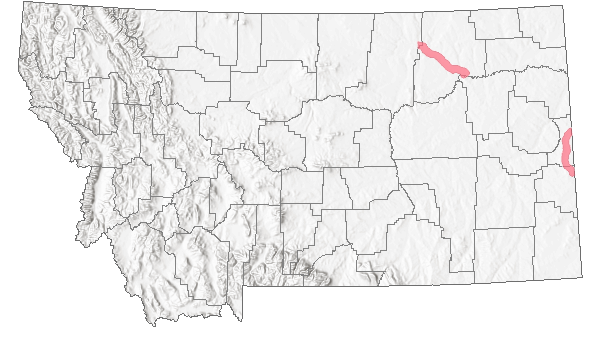
 Non-native
Non-native
Range Comments
Known only from the Lower Milk River and Beaver Creek Creek, a tributary of the Little Missouri River, Wibaux County; an introduced species (Gustafson 1996).
Observations in Montana Natural Heritage Program Database
Number of Observations: 6
(Click on the following maps and charts to see full sized version)
Map Help and Descriptions
Relative Density
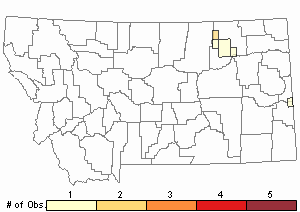
Recency
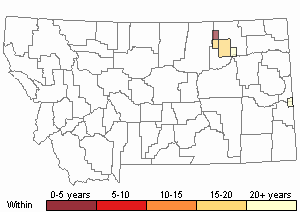

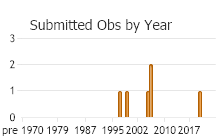
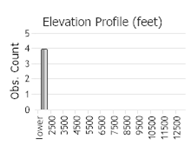 (Observations spanning multiple months or years are excluded from time charts)
(Observations spanning multiple months or years are excluded from time charts)
Migration
Adult freshwater mussels are mostly sedentary and spend their lives near the area where they first settled as juveniles. They will move short distances (a few meters) during spawning or if prompted by a stimulus such as a water disturbance nearby, exposure due to low water, or seasonal temperature changes. They may burrow into sediments (often doing so in the fall and emerging in the spring) or move away from the area horizontally.
Most dispersal takes places through there host fish, especially the carp.
Habitat
This mussel has been found to occupy very shallow waters and habitats as deep as 20 feet. The White Heelsplitter prefers pools or sluggish streams with a mud, sand, or fine gravel bottom.Occurs in fine mud in deep pools (Gustafson 1996).
Food Habits
Freshwater mussels are mostly filter-feeders, siphoning in floating particulate organic materials (small plant or animal) from the water column and straining out the particles and expel the strained water. Pedal feeding with the foot muscle has also been observed, mostly in juveniles and younger age-classes.
Ecology
Known host fish species include the Common Carp, Green Sunfish, Largemouth Bass, White Crappie, Orangespotted Sunfish and Banded Killfish
Reproductive Characteristics
"The breeding season lasts from at least August to May. Glochidia are subtriangular, with hooks, and measure from 0.28 to 0.34 mm in length and 0.30 to 0.34 mm in height. Known host fish species include the Common Carp, Green Sunfish, Largemouth Bass, White Crappie, Orangespotted Sunfish and Banded Killfish (Clarke 1981:282).
Stewardship Responsibility
Threats or Limiting Factors
Threats to freshwater mussels and their habitats are thought to include: Pollution, Diversion of rivers for irrigation, hydroelectric and water supply projects, Elimination of natural fish hosts, Eutropification due to agricultural runoff and urbanization
References
- Literature Cited AboveLegend:
 View Online Publication
View Online Publication Clarke, A.H. 1981. The freshwater molluscs of Canada. National Museum of Natural Sciences, National Museums of Canada, Ottawa. 446 pp.
Clarke, A.H. 1981. The freshwater molluscs of Canada. National Museum of Natural Sciences, National Museums of Canada, Ottawa. 446 pp. La Rocque, A. 1967. Pleistocene Mollusca of Ohio. Department of Natural Resources, Division of Geological Survey Bulletin 62, Part 2. 113-365 + 8 plates.
La Rocque, A. 1967. Pleistocene Mollusca of Ohio. Department of Natural Resources, Division of Geological Survey Bulletin 62, Part 2. 113-365 + 8 plates. Miller, K.B. and D.L. Gustafson. 1996. Distribution records of the Odonata of Montana. Bulletin of American Odonatology 3(4):75-88.
Miller, K.B. and D.L. Gustafson. 1996. Distribution records of the Odonata of Montana. Bulletin of American Odonatology 3(4):75-88.
- Web Search Engines for Articles on "White Heelsplitter"
- Additional Sources of Information Related to "Mussels / Clams"





